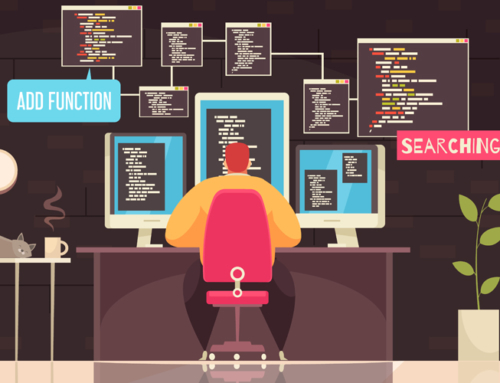Remote code execution attacks are a serious threat to modern web applications and their popularity has only increased over the last few years.
These attacks look for vulnerabilities in your web application in order to execute arbitrary code.
Stopping these attacks before they happen starts with being able to prevent a code injection vulnerability and continues with vital cybersecurity services like application security management.
This article will walk you through the web application security information your dev team needs to prevent remote code execution.
What Is A Remote Code Execution Attack?
A remote code execution attack allows a remote user to execute arbitrary code within your application or servers. They range in severity from co-opting your computing power to gaining complete control of your systems and data. These RCE attacks all begin with a hacker taking advantage of vulnerabilities in your application or security measures.
How Remote Code Execution Attacks Are Done
RCE attacks don’t have a standard framework for how they operate. These are a diverse set of attacks that all share the same method: remote access to your systems.
These threats begin with hackers scanning your application, code, and server for any vulnerabilities. Once a vulnerability is found, hackers use remote code execution tools to trick your systems into executing arbitrary code.
After the hackers get into your system, they’re free to do as they please. This could mean stealing customer or client data, hijacking your servers to use as crypto mining rigs, or locking you out of your own web application.
The Most Common Remote Code Execution Vulnerability
There are several contenders for the most common remote code execution vulnerability. Each of these share one thing in common. They all let hackers execute arbitrary code inside your application or server.
Unsanitized Inputs
Unsanitized inputs are a critical remote code execution vulnerability, and they also open up your systems to countless other hacks.
This security vulnerability is caused when a hacker issues script or code commands through an unsanitized text field. A hacker could, for example, use an unsanitized username input to issue commands to your application.
Buffer Overflow Vulnerabilities
Buffer overflow vulnerabilities are a major risk factor for remote code execution attacks. These vulnerabilities are caused when malformed or corrupted data exceeds a buffer’s boundary and causes excess data to overwrite other memory locations.
This allows hackers to actively write lines of code to those memory locations. They can then execute commands and compromise your application and your data.
Access And Authentication Failures
Authenticating inputs and user sessions helps to prevent hackers from gaining access to deeper levels of your application. Broken authentication allows hackers to compromise user login data and assume valid session IDs. The more access the compromised user has, the more damage a hacker can do to your systems.
High Profile Remote Code Execution Attacks
Major players in the world of web applications and software have been targeted for RCE attacks. These companies and hacks represent some of the most recent RCE attacks that made waves in the cybersecurity community.
Discord And Zoom Attacks
Popular communication platforms Zoom and Discord both had high profile RCE vulnerabilities in the last few years.
In both cases, White Hat hackers identified zero-day vulnerabilities that allowed them to execute arbitrary code on the victim’s smartphone or laptop. These vulnerabilities exposed hundreds of millions of regular users to potential RCE attacks.
Windows Vulnerability Exploits
Windows has been in the news on several occasions for high-profile RCE risks. One instance involved an RCE vulnerability in the Windows Help program while another was pointed out by the FBI. Even tech giants aren’t immune to the risks posed by these attacks.
Cryptomining
Cryptomining is one of the most common uses of remote code execution tools. This style of attack looks to use RCE to transform target computers into remote cryptocurrency mining machines. With the increasing profile of cryptocurrencies, this style of RCE hack is likely to become a larger security risk.
How To Prevent Code Injection Vulnerability And RCE Attacks
Preventing RCE attacks comes down to having a strong security culture in place when you’re designing, or maintaining, a web application. RCE shares vulnerabilities with other popular attacks. Understanding these vulnerabilities will improve both your protection against RCE as well as other attacks.
Update Third-Party Software
Updating third-party software is vital for preventing RCE attacks. While we can’t always predict when a third party will issue their updates, we can build time into our development schedule for regular update checks.
Buffer Overflow Protection
Buffer overflows are harder to protect against, but there are effective strategies. Address space randomization makes it extremely difficult for hackers to identify how to use buffer overflow vulnerabilities when they do pop up. Data execution prevention identifies areas of your app’s memory as “non-executable” limiting the amount of damage that a buffer overflow could cause.
Inputs, Authentication, And Access
One of the most important lessons in web app security is to always sanitize user inputs. Wherever your users can freely input text, your dev team needs to make sure they can’t also enter malicious code.
Outside of that, strong authentication and access protocols will make sure that hackers are always limited to accounts with the least possible access. This secures your web application against unforeseen attacks by preventing hackers from having access to core systems even if they get past your existing security protocols.
Improve Your Web App Security
Security is more than just better coding practices and software plans, it’s part of your development culture. Moving towards a DevSecOps environment and working with experienced application security management teams protects your application against RCE attacks and other common threats.
You can take essential steps today such as reviewing your current security practices, building time for regular updates into your schedule, and creating a threat model to better protect your web application. These changes to your security culture represent the fundamental building blocks of good cybersecurity. Once your team starts incorporating security into their development environment, you can take the next steps in securing your web application.





